The Porsche GT4 E-Performance Is a Radical Step For EV Race Cars
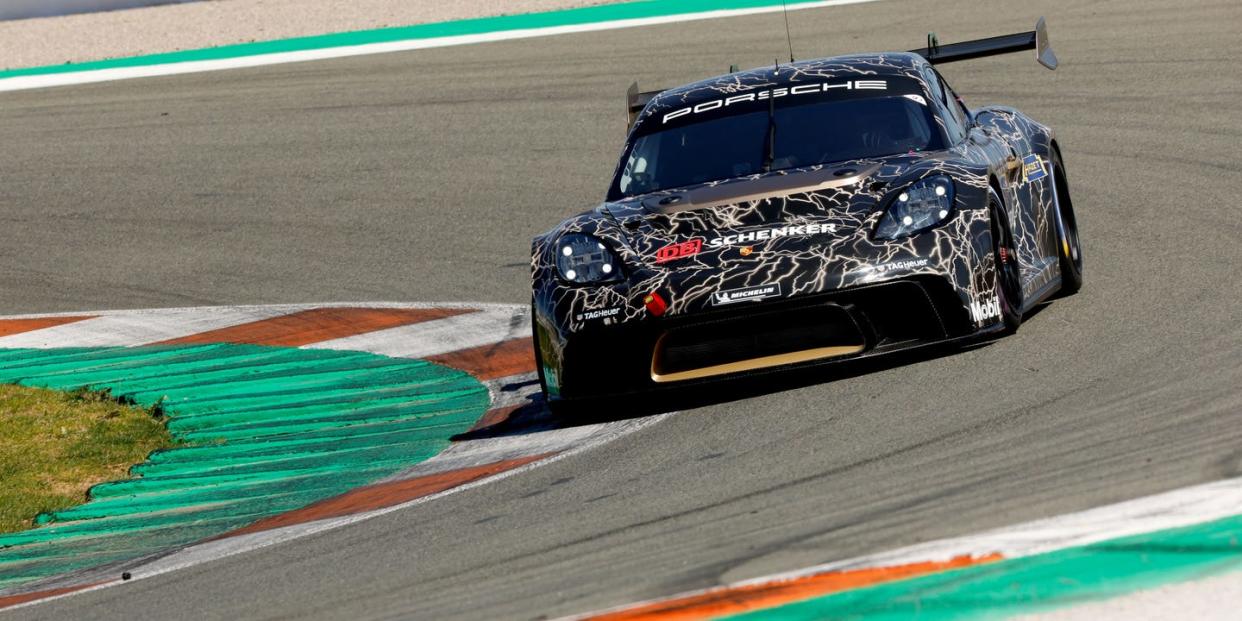
- Oops!Something went wrong.Please try again later.
At first glance, it looks like a Cayman GT4. All the cues are there, the low stance, the mid-engine proportions, the wider hips, the extended splitter, the wing. But it’s not a Cayman GT4. Porsche won’t even call it a Cayman. This is the GT4 E-Performance, Porsche’s vision for an all-electric customer race car.
While the gorgeous Mission R Concept showed what an EV Porsche race car could look like, a limiter at 70 mph means it’s more of a technology showpiece. The GT4 E-Performance is a rolling lab. It and the Mission R share a powertrain, but the E-Performance is the real, unlimited prototype for the future of electric GT racing. This car predates the Mission R, with Porsche secretly beginning testing in 2021. The car was even tested not-so-secretly alongside a gas-powered GT4 Clubsport, but nobody noticed. Probably because the gas engine drowned out the EV.
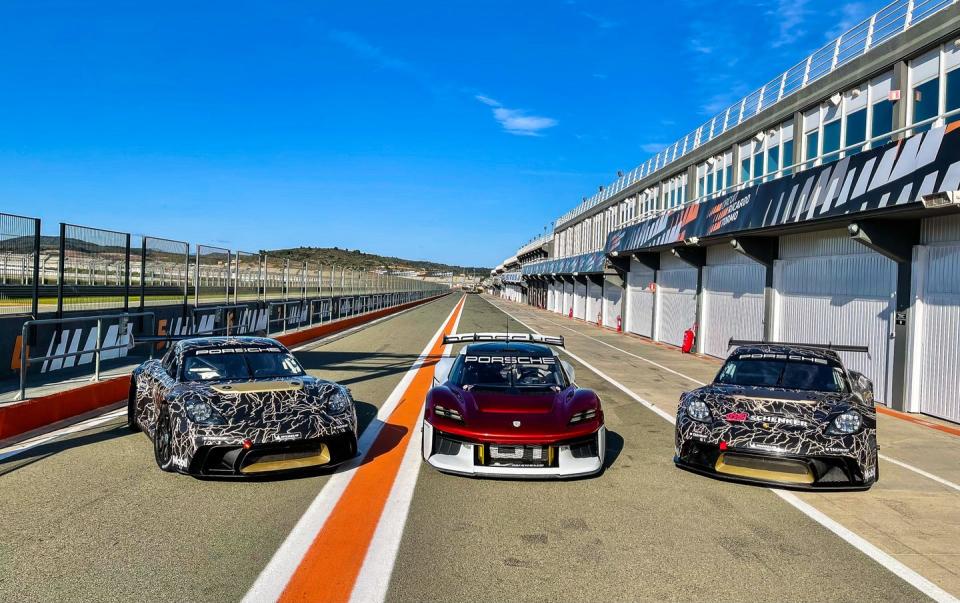
Not that the E-Performance is quiet. The straight-cut gears make it sound like a driving buzzsaw. In qualifying mode it has 938 horsepower delivered through two electric motors, one on the front axle, one on the rear (the more modest race mode has 536 hp to extend battery life). The huge brakes -- 15 inch front rotors with six-piston calipers, 14 inch rear with four-piston calipers -- are by-wire to allow for brake blending, an attempt to make the transition from regen to the actual braking system feel natural. They’re also there to heave the car down from its top speed of nearly 180 mph. It weighs about 3500 pounds, 500 pounds more than the ICE-powered Cayman GT4 RS Clubsport. Much of that added weight is on the front axle thanks to the addition of the electric motors.
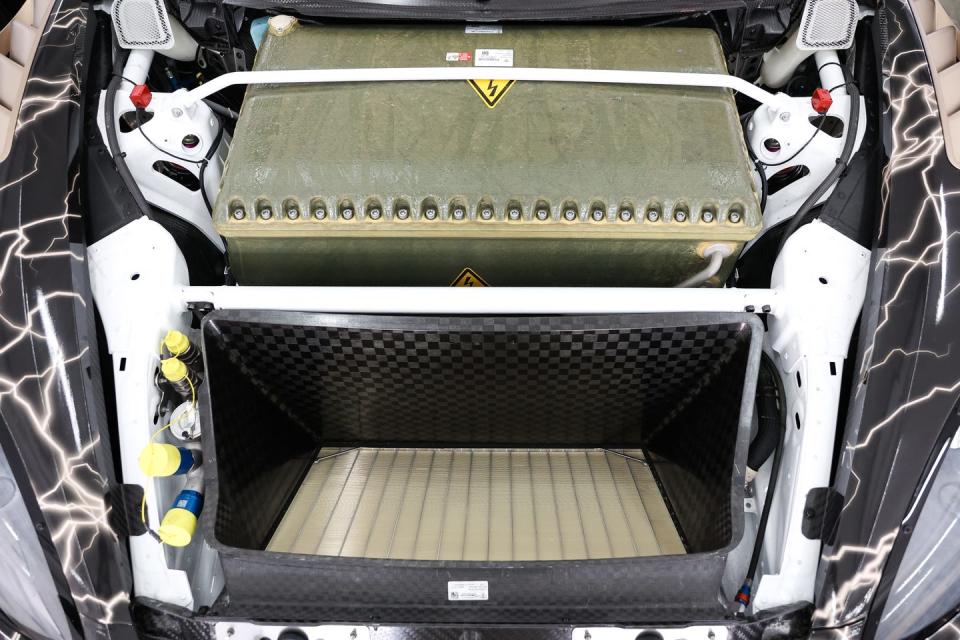
Both the Mission R and the GT4 E-Performance are based on a modified GT4 Clubsport chassis with parts from the 911 RSR race car. It’s 6.5 feet wide and has aggressive aero, but the real emphasis is cooling. The battery packs sit behind and next to you, and while the 900 volt system ensures that the 82 kWh batteries charge quickly, it also generates massive amounts of heat. The cooling solution is unique, a single unit up front that provides oil cooling to the batteries and electric motors. That deep duct in the hood houses the radiator that keeps temperatures in check.
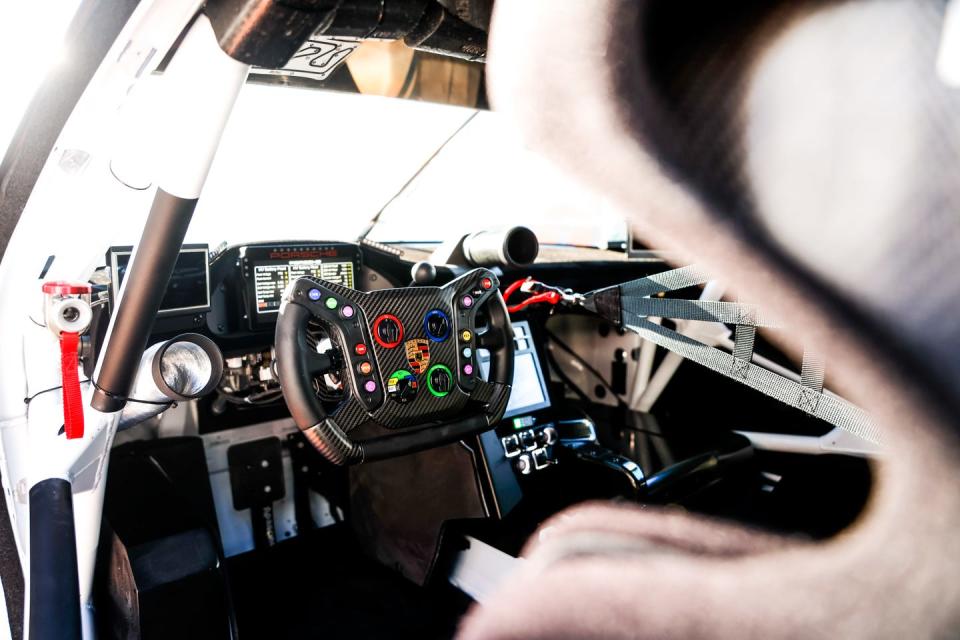
The cockpit is shockingly normal. If you’ve glanced inside any recent race cars, it’ll immediately be familiar. There is a small screen in the center console that provides the state of charge, which is new, but otherwise this is still a race car. It’s cramped, a cage taking up a large amount of real estate. One thing that is new is getting out.
This is a hugely powerful electric car, and any breach of the battery is exceedingly dangerous. Exiting the car in a situation like that requires an actual leap from the car, ensuring that you don’t touch the ground and the car at the same time. Practicing that jump, which ends up being more like a child trying to jump over a big puddle, is an easy way to look like a bit of an idiot.

Porsche gave me three sessions in the car at Circuit Ricardo Tormo, outside Valencia, Spain. Two six-lap runs in the lower-powered race mode and a brief four-lap session in the full-powered qualifying mode. Even with low power, it’s a rocket.
The added weight, particularly up front, has an obvious impact on how it needs to be driven. During a ride with Timo Bernhard, the two-time overall Le Mans winner and the outright record holder on the Nurburgring Nordschleife, we talked about what the driver needs to do to get the best out of it, most of which focused on braking. First, the brakes, which don’t have ABS, don’t like to be tromped on. A more delicate foot will get the most out of them. Second, it wants to be trail-braked. Get the weight on the nose and help it turn, or else it’ll want to plow straight on through a corner.
My first session was an adventure. Torque delivery is nuts. If you’ve driven any modern EV, the GT4 E-Performance’s response is that, but also way way more. There is no traction control, but it’s not really needed (except from a standstill, where it will do a four-wheel burnout). The way it puts power down at speed is immediate. Acceleration is constant and linear, to a point. The top speed is gearing limited, and it hits that limit just before the end of the long front straight.
Timo was also very right about how to drive the thing, because of course he was. If you don’t trail brake into Ricardo Tormo’s tight corners, it wants to go straight. A little patience, a little extra brake, and then a big move back to power gets it right up to speed. It wasn’t intimidating, either. Even though I was in a car I’d never driven on a track I’d never seen, I was two seconds off Timo’s best time after four laps. I started pushing braking points and mid-corner speeds. In most cases, it was deeply friendly. That’s when I learned what happens when you trail too much brake. The rear tires lock on entry, and then you’re along for the ride, the heavier car pivoting aggressively behind. Because the brakes are by-wire and blended, the pedal itself gave no indication that the brakes were locking up. The resulting half spin was a good learning moment for how to manage the car. It was also deeply humbling to drive a one-of-one prototype into the garage full of gravel. I need to learn how to say "sorry" in German. (Editor's note: There is no German word to sufficiently express the grave humiliation of disrespecting a Porsche.)

Another session in race mode, albeit with more conservative driving, and the car and I had become friends. It was a sweetheart. Qualifying mode changed that. I wish I had more than four laps in that mode, because adding nearly 500 hp makes it seem like a different animal. Braking points move up, the top speed is hit with a quarter of the straight left to go. It’s the sort of change in speed that recalibrates your brain, that takes the car from jovial to intimidating.
Even after riding with Timo in qualifying mode, I couldn’t wrap my head around how quickly this car can go. Porsche says that the GT4 E-Performance is quicker around many tracks than the 911 GT3 Cup. Timo’s quickest time around the track in qualifying mode would have seen him right in the middle of the grid for a GT3 race at that track. Of course, battery life being what it is, qualifying mode is only good for a few laps, with race mode intended to last around 30 to 35 minutes, a good length for a sprint race.
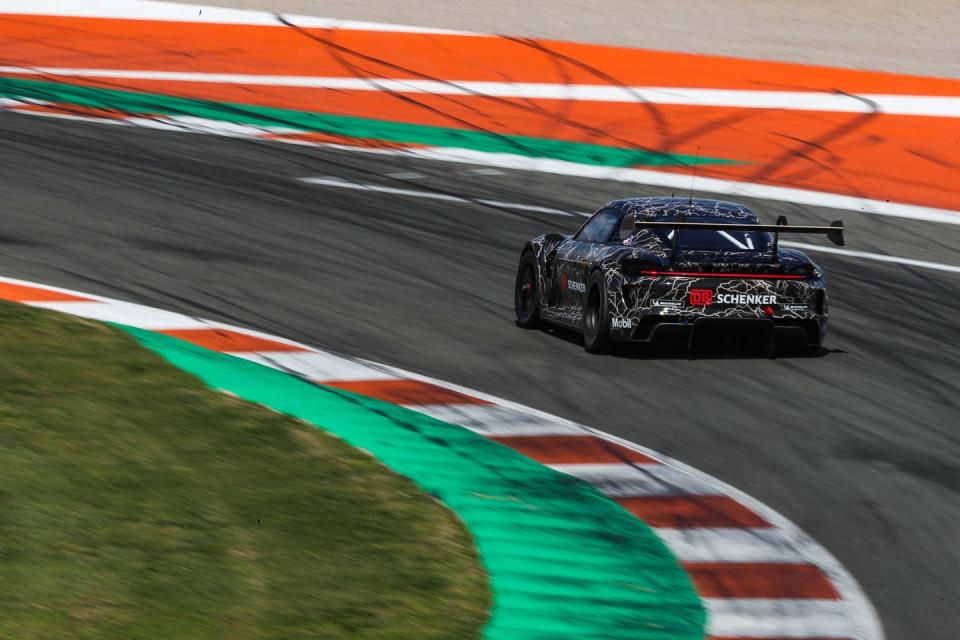
I went into this wondering if there’d be the same engagement here as in a gas-powered car. After all, the normal things a race car driver interacts with are missing. There’s no engine noise or gear changes, things that keep you involved but can also act as reference points around the track for brake and acceleration points. The by-wire brakes don’t provide the same granular feedback.
Yet it’s engaging in a different way. After my spin, I started relying more on my ears than pedal feel to suss out the brakes. While I couldn’t use gearing as a reference point, I focused more on the pitch of the electric motors. And even though there is no shifting to focus on, the manic acceleration fully commands that part of your concentration.

It’s surprising in all the right ways. The biggest thing is that it’s very hard to make an electric race car. Sure, there’s stuff like Formula E, Extreme E, eTCR, and VW’s wild I.D. R, but none of those are accessible customer cars meant to be raced by gentleman drivers. Production-based EVs frequently have issues with braking or cooling on track, something that Porsche has readily addressed from the beginning. Is this car perfect? Not quite. Some refinement of the braking system is needed and it’d be great to see the company get the weight down even more. But it is damn close. While this car won’t be sold or go into production, expect there to be a version of the all-electric next-gen Cayman that uses the tech seen here. The GT4 E-Performance is a killer start. Now Porsche will refine this concept until it’s the model for all future EV customer racing programs. Because if there’s one automaker that can figure out how to turn any road car into a race car, it’s Porsche.

You Might Also Like

